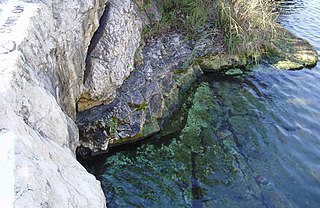| Agency overview | |
|---|---|
| Formed | 1983 |
| Jurisdiction | Laughlin, Nevada |
Big Bend Water District is a government agency that was created in 1983 to service the community of Laughlin, Nevada. It is governed by the Clark County Commission and operated by the Las Vegas Valley Water District. It is a member agency of the Southern Nevada Water Authority.
The district includes the Big Bend Water Treatment Facility which treats and supplies clean water to the 7,500 residents of Laughlin and the tourists who visit its casinos. The plant has a treatment capacity of 15 million US gallons (57,000 m3) per day and can store up to 6 million US gallons (23,000 m3) of water for later use.

Laughlin is an unincorporated community in Clark County, Nevada, United States. Laughlin lies 90 miles (140 km) south of Las Vegas, in the far southern tip of Nevada. As a resort town, it is known for its gaming and water recreation. As of the 2020 census, the population was 8,658. For statistical purposes, the United States Census Bureau has defined Laughlin as a census-designated place (CDP). It is located on the Colorado River, downstream from the Davis Dam and Lake Mohave, and directly across from the much larger Bullhead City, Arizona. The nearby communities of Bullhead City, Arizona; Needles, California; Fort Mohave, Arizona; and Mohave Valley, Arizona, bring the area's total population to about 100,000. Laughlin is also 286 miles (460 km) northeast of Los Angeles.

Barton Springs is a set of four natural water springs located at Barton Creek on the grounds of Zilker Park in Austin, Texas, resulting from water flowing through the Edwards Aquifer. The largest spring, Main Barton Spring, supplies water to Barton Springs Pool, a popular recreational destination in Austin. The smaller springs are located nearby, two with man-made structures built to contain and direct their flow. The springs are the only known habitat of the Barton Springs Salamander, an endangered species.

The Massachusetts Water Resources Authority (MWRA) is a public authority in the Commonwealth of Massachusetts that provides wholesale drinking water and sewage services to certain municipalities and industrial users in the state, primarily in the Boston area.
The Central Contra Costa Sanitary District (CCCSD), also called Central San, provides sanitary sewage transport and treatment for the central portion of Contra Costa County, California. The main facility is a 54-million-US-gallon (200,000 m3) per day treatment plant in residential Martinez, California and it provides service to approx 462,000 residents. It operates and maintains 1,500 miles (2,400 km) of sewer lines out of its second location in Walnut Creek, California. It is a California Energy Commission Showcase Plant.

The Southern Nevada Water Authority (SNWA) is a government agency that was founded in 1991 to manage Southern Nevada's water needs on a regional basis in Clark County.
The Clark County Water Reclamation District (District) is a government wastewater treatment agency in Clark County, Nevada. As a member of the Southern Nevada Water Authority, its mission is to treat millions of gallons of wastewater that is produced every day. The District is the largest water treatment agency in Southern Nevada and is responsible for treating wastewater from unincorporated parts of Clark County within the Las Vegas Valley, including most of the Las Vegas Strip, and the communities of Blue Diamond, Moapa Valley, Indian Springs, Laughlin, and Searchlight.

The Metropolitan Water District of Southern California is a regional wholesaler and the largest supplier of treated water in the United States. The name is usually shortened to "Met," "Metropolitan," or "MWD." It is a cooperative of fourteen cities, eleven municipal water districts, and one county water authority, that provides water to 19 million people in a 5,200-square-mile (13,000 km2) service area. It was created by an act of the California State Legislature in 1928, primarily to build and operate the Colorado River Aqueduct. Metropolitan became the first contractor to the State Water Project in 1960.

The Pine Bend Refinery is the largest oil refinery in Minnesota, located in the Twin Cities suburbs of Rosemount and Inver Grove Heights next to southern split of U.S. Highway 52 and Minnesota State Highway 55. The refinery is notable for being the largest in the United States to be located in a state without any oil wells. Overall, it ranked 14th in the country as of 2012 by production, with a nameplate capacity of 320,000 barrels (51,000 m3) per day. The facility is owned by Flint Hills Resources (FHR), a subsidiary of Koch Industries.
Water supply and sanitation in Singapore are intricately linked to the historical development of Singapore. It is characterised by a number of outstanding achievements in a challenging environment with geographical limitations. Access to water in Singapore is universal, affordable, efficient and of high quality.

The New River flows north from near Cerro Prieto, through the city of Mexicali, Baja California, Mexico, into the United States through the city of Calexico, California, towards the Salton Sea. The river channel has existed since pre-historic times. The river as known today formed from a levee failure and massive flooding that filled the Salton Sea.

The District of Columbia Water and Sewer Authority(DC Water) provides drinking water, sewage collection, and sewage treatment for Washington, D.C. The utility also provides wholesale wastewater treatment services to several adjoining municipalities in Maryland and Virginia, and maintains more than 9,000 public fire hydrants in Washington, D.C.
Coal pipelines are pipelines used to transport coal from where it is mined to where it is consumed. For very short distances, large trucks are used to transport coal, but trains and barges are preferred for long distances. In some cases it is more economical to move the coal by pipeline than by train or barge. This can happen when there is no suitable railway or waterway to transport the coal, or when it must be moved very long distances.

The Metropolitan Water Reclamation District of Greater Chicago (MWRD), originally known as the Sanitary District of Chicago, is a special-purpose district chartered to operate in Cook County, Illinois since 1889. Although its name may imply otherwise, it is not a part of the City of Chicago's local government but is created by Illinois state government with an elected Board of Commissioners. The MWRD's main purposes are the reclamation and treatment of wastewater and flood water abatement in Cook County to protect the health and safety of citizens and of area waterways. In 1900, the District notably reversed the flow of the Chicago River, and it is currently involved in the large multi-decade construction of the "Deep Tunnel", Tunnel and Reservoir Plan (TARP).
Dallas Water Utilities (DWU) is the water and wastewater service operated by the City of Dallas, Texas, in the United States. DWU is a non-profit City of Dallas department that provides services to the city and 31 nearby communities, employs approximately 1450 people, and consists of 26 programs. DWU's budget is completely funded through the rates charged for water and wastewater services provided to customers. Rates are based on the cost of providing the services. The department does not receive any tax revenues. Primary authority and rules for the department are listed in Chapter 49 of the Dallas City Code.

The New York City Department of Environmental Protection (DEP) is the department of the government of New York City that manages the city's water supply and works to reduce air, noise, and hazardous materials pollution.
Water supply and sanitation in the United States involves a number of issues including water scarcity, pollution, a backlog of investment, concerns about the affordability of water for the poorest, and a rapidly retiring workforce. Increased variability and intensity of rainfall as a result of climate change is expected to produce both more severe droughts and flooding, with potentially serious consequences for water supply and for pollution from combined sewer overflows. Droughts are likely to particularly affect the 66 percent of Americans whose communities depend on surface water. As for drinking water quality, there are concerns about disinfection by-products, lead, perchlorates, PFAS and pharmaceutical substances, but generally drinking water quality in the U.S. is good.
The Reno earthquakes of 2008, also known as the "Mogul-Somersett earthquake sequence", occurred in or near the western Reno, Nevada, suburbs of Mogul and Somersett. The earthquake swarm began in February 2008, but the first significant quake of the series occurred on April 15, 2008, registering a 3.6 magnitude. On April 24, 2008, two quakes in the same area registered 4.1 and 4.2. On April 25, 2008, the quake of largest magnitude occurred, registering 4.7 on the Richter scale and causing damage in the immediate area around the epicenter, including destroying 200 feet (61 m) of a wooden flume supplying water from the Highland Ditch, also known as the Highland Ditch flume. The flume carried up to 50 million US gallons (190,000 m3) a day from the Highland Ditch to Reno's Chalk Bluff Water Treatment Facility and another 5 million US gallons (19,000 m3) to area irrigation users.

California's interconnected water system serves over 30 million people and irrigates over 5,680,000 acres (2,300,000 ha) of farmland. As the world's largest, most productive, and potentially most controversial water system, it manages over 40 million acre-feet (49 km3) of water per year.

The Mokelumne Aqueduct is a 95-mile (153 km) water conveyance system in central California, United States. The aqueduct is supplied by the Mokelumne River and provides water to 35 municipalities in the East Bay in the San Francisco Bay Area. The aqueduct and the associated dams, pipelines, treatment plants and hydroelectric system are owned and operated by the East Bay Municipal Utility District (EBMUD) and provide over 90 percent of the water used by the agency.
Tampa Bay Water (TBW) is a regional wholesale drinking water utility that serves customers in the Tampa Bay, Florida region. The agency is a special district of the state created by inter-local agreement among six member governments. A nine-member board of directors composed of two elected commissioners from each member county and one elected representative from each member city oversees the policy decisions of the agency. The member governments that make up the board of directors are: The cities of New Port Richey, St. Petersburg, Florida, and Tampa, and Hillsborough County, Pasco County, and Pinellas County. These member governments provide water to over 2.5 million citizens.